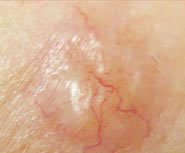Nodular Basal Cell Cancer is considered the “classic” Basal Cell Cancer and is one of the most common conditions that I encounter and treat in my The Woodlands dermatology and Conroe dermatology offices. Approximately, 80% of all Basal Cell Cancers are in the Nodular Basal Cell Cancer category. Unlike Superficial Basal Cell Cancers which are most often found on the arms and trunk, Nodular Basal Cell Cancer is most commonly found on the face. The nose is the most common area on the face to encounter a Nodular Basal Cell Cancer. Nodular Basal Cell Cancers have a “pearly” appearance in which they are clear to semitranslucent and begin as a small papule that grows into a larger nodule. Nodular Basal Cell Cancers have a characteristic rolled border in which the edges of the lesion are turned upwards. When examined with a dermatoscope, they have small telangiectasias (blood vessels) coursing through the surface and this anatomical finding explains why Basal Cell Cancers bleed very easily. They can sometimes be found with a crust or scab on the surface due to their proclivity to bleed. Treatment of Nodular Basal Cell Cancers usually involves excision of the Basal Cell Cancer in the dermatology office using local anesthesia but they can be treated with electrodessication and curretage or Mohs surgery.





